
Influence of Seed: Water Ratio and Shredding Time on Dehulling Process of Pigeon Pea
*Corresponding Author(s):
Subuola B FasoyiroInstitute Of Agricultural Research And Training, PMB 5029, Moor Plantation, Ibadan, Nigeria
Tel:+234 8052281883,
Email:subuolafasoyiro@gmail.com
Abstract
Pigeon pea seeds were pre-treated by blanching and dehulled by shredding at different times and varying seed to water ratio (seed: water), using a simple blender. Shredded fractions were weighed and used to calculate dehulling yields, as well as evaluated visually for brokenness of shells. Yields of total dehulled pigeon pea samples at 1:1 and 1:1.5 seed: water (111.72-154.68 g) doubled that which were obtained at 2:1 seed: water (53.69-60.49 g). Negative dehulling indices of -0.35 to -0.18 were obtained for pigeon pea samples PP1, PP2, and PP3 with seed: water of 2:1 and shredded for 10, 20 and 30 sec, respectively, which were significantly different at alpha level of 0.05 from samples with seed: water of 1:1 and 1:1.5. Degree of dehulling and dehulling efficiency increased with a decrease in seed: water ratio and increased shredding times. Optimal combinations of seed: water ratios with shredding time that seems to improve pigeon pea dehulling process were either seed: water at 1:1 or 1:1.5 for shredding time of 30 sec. The information from this research may be of interest to individuals who are looking for low-cost ways to improve dehulling efficiency of pigeon pea for the manufacture of flour or other uses.
Keywords
Dehulling process; Legume; Low cost; Pigeon pea
INTRODUCTION
Pigeon pea, Cajanus cajan, also known as red gram, is found throughout tropical and subtropical areas of the world, from about 30°N to about 30°S of the equator [1]. In West Africa, the mature seeds are soaked in water, cooked, and eaten alone or with rice, yams, or a variety of vegetables. In the Caribbean, pigeon pea may be harvested green, cut, steamed, and canned or the legume may be processed into dry seeds, cooked, and canned for export [1].
In Nigeria, pigeon pea is an underutilized legume with great potential to address protein deficiency among resource-poor populations, if improvements can be made with processing and utilization technologies [2]. The underutilization of pigeon pea can be attributed to the presence of mucilage and gum, forming a strong bond between the hulls and cotyledons. The structure of the mucilage and gums present in the interface between the husk and cotyledons play an important role in the efficiency of dehulling of these legume grains [3]. Mucilage and gums of legume seeds produce a network of cellulosic micro fibrils embedded in a matrix of Non-Starch Polysaccharides (NSP) and proteins [4,5], making dehulling processes difficult.
Desirable quality attributes of legumes for human consumption include dehulling efficiency and cooking quality. Generally, legumes are dehulled to improve their cooking and nutritional qualities and to remove anti-nutritional compounds, such as polyphenols located in the seed coat [6]. Pre-dehulling treatment involves loosening the husk from the cotyledons by soaking, cooking, blanching, use of chemical solutions, or a combination of processes [7]. Most dehulling processes are not only complex, but not easily adaptable for home use or for cottage industries, and therefore, are not adopted [8-10]. Therefore, this study was carried out to determine the effect of shredding time and seed: water ratio on dehulling parameters of pigeon pea, using a simple grinder adaptable for home and cottage use. The information from this study may provide individuals with an easier way to extract the hulls, allowing for more extensive use of the legume.
MATERIALS AND METHODS
Materials
Pigeon pea seeds were purchased online from Barry Farm Foods (Wapakoneta, Ohio). The seeds were already cleaned and packaged in air-tight polyethylene bags. The seeds were stored at 23+20C prior to use.
Pre-treatment
Pigeon pea seeds (2 kg) were weighed, washed, and tap water was added at ratio of 1:3 (weight/volume). The seeds were blanched for 30 min in boiling water, washed under running tap water, and cooled to 25-300C within 5 min.
Dehulling process
Blanched pigeon pea (200 g) were divided and water added to provide seed: water ratios of 2:1, 1.5:1, and 1:1. Resulting seed: water samples were dehulled by shredding in a blender (Model number 56250; Type B29; Hamilton Beach) for 10, 20, or 30 sec. Dehulled seeds were rinsed under running water for 3 min to removed hulls. The dehulled seeds and hulls were collected separately before calculation for yields were done.
Moisture content of seeds
The initial moisture content of blanched and dehulled seeds was determined by drying 5 g of the seeds at 130+30C for 2 h in a convection oven [11] and calculating moisture loss between wet and dried seeds.
Dehulling data collected
Dehulled data were collected using the method of Ikebudu et al. [12]. Briefly, 200 g of processed seeds at the various seed: water and processing times were separated manually into the following categories and weighed: undehulled seeds (W3), whole unbroken dehulled seeds (Wu), broken dehulled seeds (W2), tiny seed fragments (Wb), and hulls (Wh). W1 is initial weight of undehulled pigeon pea. The readings were taken four times.
Calculation of dehulling parameters
Dehulling parameters are Dehulling Index (DI), Degree of Dehulling (%DD), Dehulling Efficiency (%DE) and Dehulling Loss (%DL). These calculations were done by the method of Sreerama et al. [6].
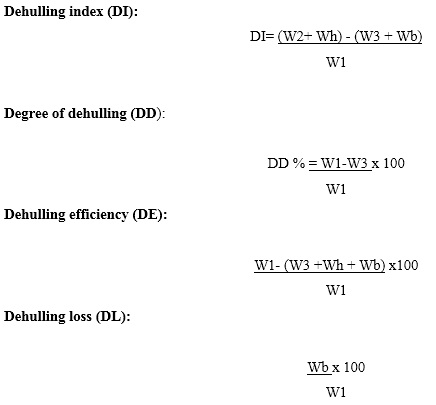 Statistical analysis
Statistical analysis
The experimental design was 3x3 factorial (3 seed: water ratios x 3 shredding times). Statistical analyses were carried out using IBM SPSS Statistics version 23 released, 2015 (IBM Corporation, Armonk, NY). Univariate Analysis of Variance (ANOVA) was used to determine the difference between means using an alpha of 0.05.
RESULT AND DISCUSSION
In this study, pigeon pea seeds at different seed: water ratio and shredding times were dehulled. Figure 1 demonstrates processing stages of dehulling pigeon pea seeds. Figure 1A demonstrates the visual observations of pigeon pea seeds before blanching, after blanching, and after cooling with water. Blanching causes the pigeon pea seeds to swell, as evidenced by the saturated seed coats, thereby allowing water to penetrate the cotyledons were observed manually. The initial moisture content of the blanched seeds was 42.5-45%, while moisture contents of the dehulled seeds varied from 41.5-46.5%. After blanching it was observed that the seed coats shrunk away from the cotyledons and became more transparent, allowing easy removal of the seed coats during shredding. Blanching also may lead to loss of mucilaginous substances in the seed coat, which was observed by the darkening of the blanching water. Figure 1B demonstrates dehulled pigeon seeds of different bean to water ratio and shredding times. It was observed that the degree of brokenness of seeds increased with shredding times. Sample PP1 has the least brokenness and PP9 has the highest brokenness. Hulls were better removed at shredding times of 30 sec. Dehulling increased with seed: water ratio from 2:1 to 1:1 to 1:1.5.
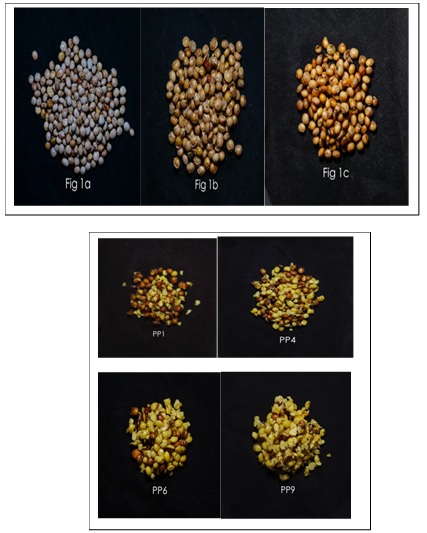 Figure1: Processing stages of dehulling pigeon pea seeds. Figure 1A. Samples of dehulled pigeon pea seeds before blanching (Figure 1A), after blanching (Figure 1B) and after cooling (Figure 1C); Figure 1B. PP1 (seed: water ratio 2:1, shredding time 10 sec; PP4 (seed: water ratio 2:1, shredding time 10 sec), PP6 (seed: water ratio 1:1, shredding time 30 sec), PP9 (seed: water ratio 1:1.5, shredding time 30 sec).
Figure1: Processing stages of dehulling pigeon pea seeds. Figure 1A. Samples of dehulled pigeon pea seeds before blanching (Figure 1A), after blanching (Figure 1B) and after cooling (Figure 1C); Figure 1B. PP1 (seed: water ratio 2:1, shredding time 10 sec; PP4 (seed: water ratio 2:1, shredding time 10 sec), PP6 (seed: water ratio 1:1, shredding time 30 sec), PP9 (seed: water ratio 1:1.5, shredding time 30 sec).
Table 1 shows the yield of different fractions of pigeon pea seeds obtained from dehulling processes while figure 2 demonstrates the plot of the yields of different fractions showing trends of seed water; ratio and shredding time on yield. Undehulled pigeon pea for samples PP1, PP2 and PP3 (with seed: water 2:1) was 124.34 g, 123.13 g and 120.21 g respectively, which were significantly different at alpha 0.05 from samples at of seed: water of 1:1 and 1:1.5. Samples PP6 and PP9 (seed: water 1:1, shredding time 30 sec and seed: water ratio 1:1.5 shredding time 30 sec) had preferred lowest means of undehulled seeds while PP1 (seed: water ratio 2:1, shredding time 10 sec) had the highest yield of undehulled seeds of 124.34 g. Generally, it was observed that that percentage of undehulled beans decreased with decrease in seed: water and increase in shredding time. Sample PP5 (seed: water ratio 2:1, shredding time 20 sec) had the highest percentage of whole dehulled seeds of 12.37%, whereas samples PP7, PP8 and PP9 (seed: water of 1:1.5), had 100% brokenness of seeds. Broken dehulled pigeon pea seeds increased generally with shredding times for the various samples of seed: water ratio for shredding. Amount of shredded samples at 1:1 and 1:1.5 seed to water ratio doubled that which was obtained at 2:1 seed: water ratio. Broken dehulled seeds ranged from 51.99 g to 154.68 g (25.99% to 77.34%).
|
Samples |
Undehulled Beans (g) |
Whole Dehulled Beans (g) |
Broken Dehulled Beans (g) |
Total Dehulled Beans (g) |
Tiny fragment/ Powdery (g) |
Hull (g) |
|
PP1 |
124.34a+12.83 |
2.46c+1.04 |
51.99c+6.38 |
53.69c+3.64 |
4.53c+1.06 |
7.88d+2.44 |
|
PP2 |
123.13a+11.29 |
4.17b+2.44 |
57.82c+3.49 |
55.93c+4.33 |
4.42c+1.97 |
9.39d+2.68 |
|
PP3 |
120.21a+5.10 |
1.31c+0.98 |
62.35c+4.02 |
60.49c+1.01 |
9.85a+1.78 |
19.51c+4.25 |
|
PP4 |
58.59b+6.84 |
2.42c+1.46 |
117.20b+16.32 |
111.19b+11.6 |
6.12ab+1.35 |
22.60bc+1.76 |
|
PP5 |
29.42c+4.03
|
12.37a+2.48 |
123.07b+7.19 |
128.91b+11.28 |
3.38c+1.61 |
21.54b+3.17 |
|
PP6 |
3.64e+1.77 |
6.63b+1.98 |
146.25a+4.79 |
154.27a+6.07 |
4.84b+1.26 |
28.55a+2.88 |
|
PP7 |
40.89c+5.46 |
- |
122.29b+13.34 |
118.74b+10.61 |
8.06ab+3.74 |
26.30ab+4.69
|
|
PP8 |
23.68cd+4.14 |
- |
139.72ab+3.55 |
139.72ab+3.07 |
7.62ab+2.76 |
21.41ab+3.73 |
|
PP9 |
4.14e+1.62 |
- |
154.68a+8.81 |
154.68a+7.37 |
8.17ab+1.81 |
30.74a+3.92 |
Table 1: Yield of different fractions of pigeon pea seeds obtained from dehulling processes.
Note: Means in the same column not followed by the same superscript are significantly different at an of alpha 0.05. Yield (g) of different fractions of pigeon pea samples and standard deviations are mean of (n=4; number of dehulled pigeon pea samples). Key; PP1- seed: water ratio 2:1, shredding time 10 sec, seed: water ratio 2:1, shredding time 10 sec, PP2- seed: water ratio 2:1, shredding time 20 sec, PP3- seed: water ratio 2:1, shredding time 30 sec, PP4- seed: water ratio 1:1, shredding time 10 sec, PP5- seed: water ratio 1:1, shredding time 20 sec, PP6- seed: water ratio 1:1, shredding time 30 sec, PP7 seed: water ratio 1:1.5, shredding time 10 sec, PP8- seed: water ratio 1:1.5, shredding time 20 sec, PP9- seed: water rato1;1.5, shredding time 30 sec.
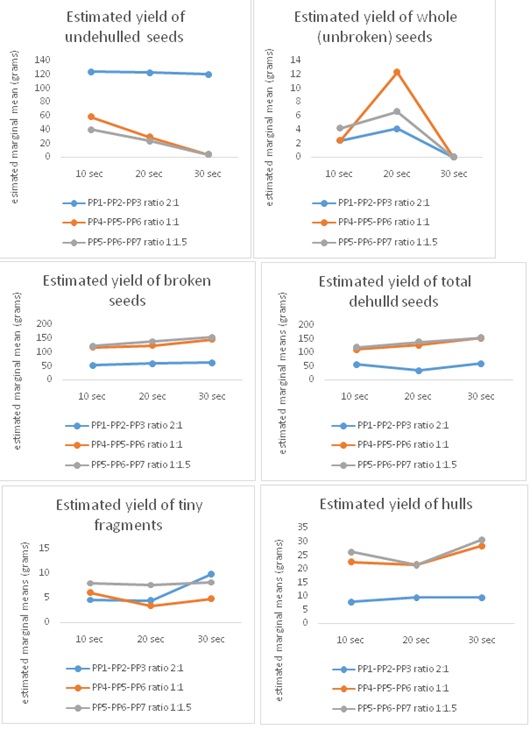 Figure 2: Plots of yield of different fractions of dehulled pigeon pea seeds.
Figure 2: Plots of yield of different fractions of dehulled pigeon pea seeds.
Note: Yield (g) of different fractions of pigeon pea samples and standard deviations are mean of (n=4; number of dehulled pigeon pea samples). Key; PP1- seed: water ratio 2:1, shredding time 10 sec, seed: water ratio 2:1, shredding time 10 sec, PP2- seed: water ratio 2:1, shredding time 20 sec, PP3- seed: water ratio 2:1, shredding time 30 sec, PP4- seed: water ratio 1:1, shredding time 10 sec, PP5- seed: water ratio 1:1, shredding time 20 sec, PP6- seed: water ratio 1:1, shredding time 30 sec, PP7 seed: water ratio 1:1.5, shredding time 10 sec, PP8- seed: water ratio 1:1.5, shredding time 20 sec, PP9- seed: water rato1;1.5, shredding time 30 sec.
Total yield of dehulled seeds (whole plus broken) ranged from 53.69 g to 154.68 g. Highest deshelled yields were obtained from sample PP9 (seed: water ratio 1:1.5, shredding time 30 sec) with seed recovery of 154.68 g (77.34%) and total brokenness of seeds (100%); which was not significantly different at alpha 0.05from PP6 (seed: water ratio 2:1, shredding time 30 sec) with total seed recovery of 154.27 g (77.12%). Singh (1995) reported a maximum theory recovery of dehulled beans of 87-89% for improved dehulling processes while traditional processes had a total recovery of 65-75%. The maximum yield obtained in this study was lower than the maximum yield recovery reported from previous processes but higher that what was obtainable from traditional processes reported. The lowest average tiny fragment of the seed was from PP5 (seed: water ratio 1:1, shredding time 20 sec). Samples of seed: water ratio 2:1 had the lowest yield of hulls indicating more of undehulled seeds while those of seed: water ratio 1:1 and 1:1.1.5 were higher and at a closer range.
Dehulling index is usually a value of maximum of 1 relating broken seeds, whole unbroken with hulls and lost fragment in connection to amount of seeds dehulled. Dehulling Index (Figure 3) generally increased with shredding time and seed to water ratio. The dehulling index for samples PP1, PP2 and PP3 (seed: water ratio 1:1) were negative for the different shredding time. Sample of seed: water ratio 1:1.5 had highest level of dehulling index compared to samples of seed: water ratios 2:1 and 1:1 with shredding times. Sample PP9 (seed: water ratio 1:1.5, shredding time 30 sec) had the highest dehulling index of 0.87 while the lowest was for sample PP1 (seed: water ratio 1:1, shredding time 10 sec) at -0.35. Sreerama et al. [6], obtained a higher dehulling index of 0.93 for xylanse-treated horse gram.
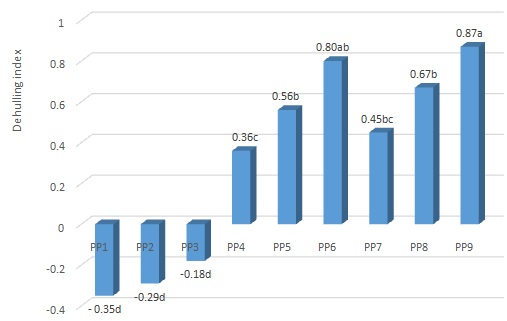 Figure 3: Dehulling index of pigeon pea samples (DI).
Figure 3: Dehulling index of pigeon pea samples (DI).
Note: Different letters represent significant difference of dehulling index of pigeon pea samples at an alpha of 0.05. Key; PP1- seed: water ratio 2:1, shredding time 10 sec, seed: water ratio 2:1, shredding time 10 sec, PP2- seed: water ratio 2:1, shredding time 20 sec, PP3- seed: water ratio 2:1, shredding time 30 sec, PP4- seed: water ratio 1:1, shredding time 10 sec, PP5- seed: water ratio 1:1, shredding time 20 sec, PP6- seed: water ratio 1:1, shredding time 30 sec, PP7 seed: water ratio 1:1.5, shredding time 10 sec, PP8- seed: water ratio 1:1.5, shredding time 20 sec, PP9- seed: water rato1;1.5, shredding time 30 sec.
Figures 4 and 5 demonstrate the Degree of Dehulling (%DD) and Dehulling Efficiency (%DE) of the pigeon pea samples. The degree of dehulling or hull removal is the percentage of dehulled beans to the initial weight of sample taken for dehulling. Dehulling efficiency is an estimate of the efficiency of producing the major product, dehulled seeds. The %DD and %DE increased with seed: water and shredding time. Generally, samples of seed: water ratios 1:1.5 had the highest %DD with shredding times compared to samples of seed: water ratios 2:1 and 1:1, with shredding times, but there was not much difference between PP6 (seed: water ratio 1:1, shredding time 30 sec), PP8 (seed: water ratio 1:1.5, shredding time 20 sec and PP8 (seed: water ratio 1:1.5, shredding 30 sec). Both the samples of seed: water ratios 1:1.5 and 1.1 shredded for 30 sec (PP6 and PP9) had the highest Dehulling Efficiency (%DE) at 79.9% and 79.8 respectively. Lowest degree of dehulling was recorded for PP1 (seed: water ratio 1:1, shredding time 10 sec) at 33.3% and lowest dehulling efficiency for PP3 (seed: water ratio 1:1, shredding time 30 sec) at 27.2%. Sreerama et al. [6], also reported highest degree of dehulling of 98.4% for xylanase-treated horse gram. Goyal et al. [13], also reported increased dehulling efficiency with dehulling time with optimal dehulling efficiency of 83.2% obtained for pigeon pea pre-treated with 0.3% mustard oil.
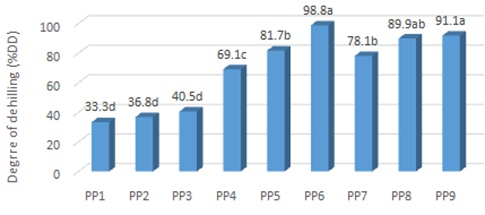 Figure 4: Percentage degree of dehulling of pigeon pea samples.
Figure 4: Percentage degree of dehulling of pigeon pea samples.
Note: Different letters represent significant difference of degree of dehulling of pigeon pea samples at an alpha of 0.05. Key; PP1- seed: water ratio 2:1, shredding time 10 sec, seed: water ratio 2:1, shredding time 10 sec, PP2- seed: water ratio 2:1, shredding time 20 sec, PP3- seed: water ratio 2:1, shredding time 30 sec, PP4- seed: water ratio 1:1, shredding time 10 sec, PP5- seed: water ratio 1:1, shredding time 20 sec, PP6- seed: water ratio 1:1, shredding time 30 sec, PP7 seed: water ratio 1:1.5, shredding time 10 sec, PP8- seed: water ratio 1:1.5, shredding time 20 sec, PP9- seed: water rato1;1.5, shredding time 30 sec.
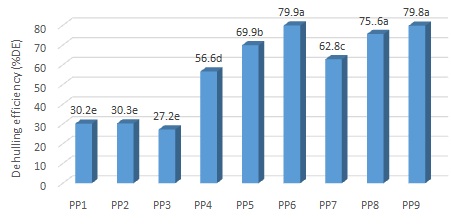 Figure 5: Percentage dehulling efficency of pigeon pea samples.
Figure 5: Percentage dehulling efficency of pigeon pea samples.
Note: Different letters represent significant difference of dehulling efficiency of pigeon pea samples at an alpha of 0.05. Key; PP1- seed: water ratio 2:1, shredding time 10 sec, seed: water ratio 2:1, shredding time 10 sec, PP2- seed: water ratio 2:1, shredding time 20 sec, PP3- seed: water ratio 2:1, shredding time 30 sec, PP4- seed: water ratio 1:1, shredding time 10 sec, PP5- seed: water ratio 1:1, shredding time 20 sec, PP6- seed: water ratio 1:1, shredding time 30 sec, PP7 seed: water ratio 1:1.5, shredding time 10 sec, PP8- seed: water ratio 1:1.5, shredding time 20 sec, PP9- seed: water rato1;1.5, shredding time 30 sec.
Figure 6 demonstrates the dehulling loss of the seeds. Dehulling loss is the percentage of broken seeds in powdery form. Dehulling Loss (%DL) was in the range of 2.26 to 4.82%, which was independent of either seed: water or the shredding time. Singh et al. [14], reported 5.5 to 6.1% dehulling loss for pigeon pea and 9 to 24.6% broken seed. Sample PP3 (seed: water of 2:1 and shredding time of 30 sec) had the highest dehulling loss, while PP6 (seed: water of 1:1 and shredding time of 30 sec) had the lowest followed by PP8 (seed: water ratio 1:1.5, shredding time 20 sec). Singh et al. [14] and Singh et al. [15], reported a dehulling loss of 4.4 to 12.8% in some studies, while Sreerama et al. [6], reported a dehulling loss of 3.1% which was observed to reduce with increasing moisture content levels in pulses. In a centrifugal process reported by Gupta and Das [16], for dehulling of sunflower, dehulling efficiency decreased with increased moisture content and feed rate.
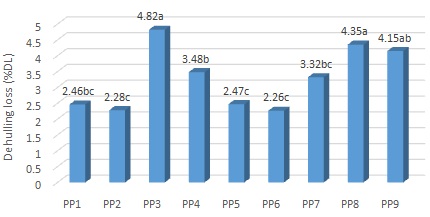 Figure 6: Percentage dehulling loss of pigeon pea samples.
Figure 6: Percentage dehulling loss of pigeon pea samples.
Note: Different letters represent significant difference of dehulling loss of pigeon pea samples at an alpha of 0.05. Key; PP1- seed: water ratio 2:1, shredding time 10 sec, seed: water ratio 2:1, shredding time 10 sec, PP2- seed: water ratio 2:1, shredding time 20 sec, PP3- seed: water ratio 2:1, shredding time 30 sec, PP4- seed: water ratio 1:1, shredding time 10 sec, PP5- seed: water ratio 1:1, shredding time 20 sec, PP6- seed: water ratio 1:1, shredding time 30 sec, PP7 seed: water ratio 1:1.5, shredding time 10 sec, PP8- seed: water ratio 1:1.5, shredding time 20 sec, PP9- seed: water rato1;1.5, shredding time 30 sec.
CONCLUSION
This study demonstrates optimal combinations of seed: water ratios with shredding time that seems to improve pigeon pea dehulling process as either seed: water ratios at 1:1 or 1:1.5 for shredding time of 30 sec. This dehulling process will not be applicable to food where whole seeds are desirable. The process will, however, find useful application to products where broken or split beans are acceptable in semi-finished products, such as in legume flour, bean porridges, bean puddings, or as a thickener. These results indicate that improved dehulling properties for pigeon pea seeds have the potential for better utilization and adoption, especially in households and cottage use where low cost technologies are required.
CONFLICT OF INTEREST
The authors acknowledge that there is no conflict of interest.
ACKNOWLEDGEMENT
The authors would like to acknowledge Pennsylvania State University Library Data Learning Centre for the statistical analysis and interpretation. This research did not receive any specific grant from funding agencies in the public, commercial, or not-for-profit sectors.
REFERENCES
- Duke JA (1981) Handbook of Legumes of World Economic Importance. Plenum Press, New York, USA.
- Nwokolo E (1996) Food and feed from legumes and oilseeds. Publisher Chapman hall, London, UK.
- Ramakrishnaiah N, Kurien PP (1983) Variability in the dehulling characteristics of pigeon pea (Cajanus cajan L.) cultivars. Journal of Food Science and Technology 20: 287-291.
- Cosgrove DJ (1997) Assembly and enlargement of the primary cell wall in plants. Annu Rev Cell Dev Biol 13: 171-201.
- Phirke PS, Bhole NG (2000) Pretreatment of pigeon pea grain for improvement of dehulling characteristics. International Journal of Food Science and Technology 35: 305-313.
- Sreerama YN, Sashikala VB, Pratape VM (2009) Effect of enzyme pre-dehulling treatments on dehulling and cooking properties. Journal of Food Engineering 92: 389-395.
- Phirke PS, Bhole NG (1999) The effect of pretreatment on the strength and dehulling properties of pigeon pea grain. International Journal of Food Science and Technology 34: 107-113.
- Singh D, Sokhananj S (1984) Cylindrical concave mechanism and chemical treatment for dehulling of pigeon pea. Agricultural Mechanization in Asia, Africa and Latin America 15: 53-58.
- Reichert RD, Ooman BD, Youngs CG (1984) Factors affecting the efficiency of abrasive type dehulling of grain legumes investigated with a new intermediate size batch dehuller. Food Science 49: 267-272.
- Phirke PS, Pumbarka S, Taore AB (1992) Evaluation of chemical pretreatment of pigeon pea grains for milling. Indian Journal of Agricultural Engineering 2: 141-142.
- AOAC (2012) Official Methods of Analysis of the Association of Official Analytical Chemists. (19th Ed). AOAC International, Maryland, USA.
- Ikebudu JA, Sokhansanj S, Tyler RT, Milne BJ, Thakor NS (2000) Grain conditioning for dehulling of canola. Canadian Agricultural Engineering 42: 27-32.
- Goyal RK, Vishwakarma RK, Wanjari OD (2008) Optimization of pigeon pea dehulling process. Biosystems Engineering 99: 56-61.
- Singh U, Santosa BAS, Rao PV (1992) Effect of dehulling methods and physical characteristics of grains on dhal yield of pigeon pea (Cajanus cajan L.) gentotypes. Journal of Food Science and Technology 29: 350-353.
- Singh U (1995) Methods of dehulling of pulses. A critical appraisal. Journal of Food Science and Technology 32: 81-93.
- Gupta RK, Das SK (1999) Performance of centrifugal dehulling system for sunflower. Journal of Food Engineering 42: 191-198.
Citation: Fasoyiro SB, Hovingh R, Gourama HG, Cutter CN (2020) Influence of Seed: Water Ratio and Shredding Time on Dehulling Process of Pigeon Pea. J Food Sci Nutr 6: 083.
Copyright: © 2020 Subuola B Fasoyiro, et al. This is an open-access article distributed under the terms of the Creative Commons Attribution License, which permits unrestricted use, distribution, and reproduction in any medium, provided the original author and source are credited.

